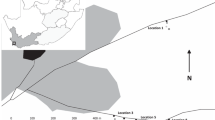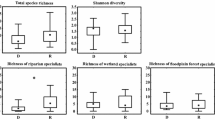Abstract
The transitions between ecosystems (ecotones) are often biodiversity hotspots, but we know little about the forces that shape them. Today, often sharp boundaries with low diversity are found between terrestrial and aquatic ecosystems. This has been attributed to environmental factors that hamper succession. However, ecosystem properties are often controlled by both bottom-up and top-down forces, but their relative importance in shaping riparian boundaries is not known. We hypothesize that (1) herbivores may enforce sharp transitions between terrestrial and aquatic ecosystems by inhibiting emergent vegetation expansion and reducing the width of the transition zone and (2) the vegetation expansion, diversity, and species turnover are related to abiotic factors in the absence of herbivores, but not in their presence. We tested these hypotheses in 50 paired grazed and ungrazed plots spread over ten wetlands, during two years. Excluding grazers increased vegetation expansion, cover, biomass, and species richness. In ungrazed plots, vegetation cover was negatively related to water depth, whereas plant species richness was negatively related to the vegetation N:P ratio. The presence of (mainly aquatic) herbivores overruled the effect of water depth on vegetation cover increase but did not interact with vegetation N:P ratio. Increased local extinction in the presence of herbivores explained the negative effect of herbivores on species richness, as local colonization rates were unaffected by grazing. We conclude that (aquatic) herbivores can strongly inhibit expansion of the riparian vegetation and reduce vegetation diversity over a range of environmental conditions. Consequently, herbivores enforce sharp boundaries between terrestrial and aquatic ecosystems.





Similar content being viewed by others
References
Bai YF, Wu JG, Clark CM, Pan QM, Zhang LX, Chen SP, Wang QB, Han XG. 2012. Grazing alters ecosystem functioning and C:N:P stoichiometry of grasslands along a regional precipitation gradient. J Appl Ecol 49:1204–15.
Bakker ES, Olff H. 2003. Impact of different-sized herbivores on recruitment opportunities for subordinate herbs in grasslands. J Veg Sci 14:465–74.
Bakker ES, Olff H, Vandenberghe C, De Maeyer K, Smit R, Gleichman JM, Vera FWM. 2004. Ecological anachronisms in the recruitment of temperate light-demanding tree species in wooded pastures. J Appl Ecol 41:571–82.
Bakker ES, Ritchie ME, Olff H, Milchunas DG, Knops JMH. 2006. Herbivore impact on grassland plant diversity depends on habitat productivity and herbivore size. Ecol Lett 9:780–8.
Bakker ES, Sarneel JM, Gulati RD, Lui Z, Van Donk E. 2013. Restoring macrophyte diversity in shallow temperate lakes: biotic versus abiotic constraints. Hydrobiologia 710:23–37.
Bakker SA, Vandenberg NJ, Speleers BP. 1994. Vegetation transitions of floating wetlands in a complex of turbaries between 1937 and 1989 as determined from aerial photographs with GIS. Vegetatio 114:161–7.
Barkman JJ, Doing H, Segal S. 1964. Kritische Bemerkungen und Vorschläge zur quantitativen Vegetationsanalyse. Acta Bot Neerl 13:394–419.
Bornette G, Puijalon S. 2011. Response of aquatic plants to abiotic factors: a review. Aquat Sci 73:1–14.
Bos D, Ydenberg R. 2011. Evaluation of alternative management strategies of muskrat Ondatra zibethicus population control using a population model. Wildl Biol 17:143–55.
Butler LG, Kielland K. 2008. Acceleration of vegetation turnover and element cycling by mammalian herbivory in riparian ecosystems. J Ecol 96:136–44.
Cadenasso ML, Pickett STA. 2000. Linking forest edge structure to edge function: mediation of herbivore damage. J Ecol 88:31–44.
Chaichana R, Leah R, Moss B. 2011. Seasonal impact of waterfowl on communities of macrophytes in a shallow lake. Aquat Bot 95:39–44.
Crawley MJ. 2007. The R Book. Chichester: Wiley.
Danell K. 1979. Reduction of aquatic vegetation following the colonization of a northern swedish lake by the muskrat, Ondatra zibethica. Oecologia 38:101–6.
Eskelinen A, Harrison S, Tuomi M. 2012. Plant traits mediate consumer and nutrient control on plant community productivity and diversity. Ecology 93:2705–18.
Estes JA, Palmisan JF. 1974. Sea otters: their role in structuring nearshore communities. Science 185:1058–60.
Evers DE, Sasser CE, Gosselink JG, Fuller DA, Visser JM. 1998. The impact of vertebrate herbivores on wetland vegetation in Atchafalaya Bay, Louisiana. Estuaries 21:1–13.
Farnsworth KD, Anderson ARA. 2001. How simple grazing rules can lead to persistent boundaries in vegetation communities. Oikos 95:15–24.
Figureuerola J, Green AJ. 2002. Dispersal of aquatic organisms by waterbirds: a review of past research and priorities for future studies. Freshwat Biol 47:483–94.
Fujita Y, Venterink HO, van Bodegom PM, Douma JC, Heil GW, Holzel N, Jablonska E, Kotowski W, Okruszko T, Pawlikowski P, de Ruiter PC, Wassen MJ. 2014. Low investment in sexual reproduction threatens plants adapted to phosphorus limitation. Nature 505:82.
Gayet G, Guillemain M, Fritz H, Mesleard F, Begnis C, Costiou A, Body G, Curtet L, Broyer J. 2011. Do mute swan (Cygnus olor) grazing, swan residence and fishpond nutrient availability interactively control macrophyte communities? Aquat Bot 95:110–16.
Gibson CWD, Brown VK. 1991. The effects of grazing on local colonization and extinction during early succession. J Veg Sci 2:291–300.
Gusewell S, Koerselman W, Verhoeven JTA. 2003. Biomass N:P ratios as indicators of nutrient limitation for plant populations in wetlands. Ecol Appl 13:372–84.
Hidding B, Sarneel JM, Bakker ES. 2014. Flooding tolerance and horizontal expansion of wetland plants: facilitation by floating mats? Aquat Bot 113:83–9.
Hillebrand H, Gruner DS, Borer ET, Bracken MES, Cleland EE, Elser JJ, Harpole WS, Ngai JT, Seabloom EW, Shurin JB, Smith JE. 2007. Consumer versus resource control of producer diversity depends on ecosystem type and producer community structure. Proc Natl Acad Sci USA 104:10904–9.
Kanga EM, Ogutu JO, Piepho HP, Olff H. 2013. Hippopotamus and livestock grazing: influences on riparian vegetation and facilitation of other herbivores in the Mara Region of Kenya. Landsc Ecol Eng 9:47–58.
Koerselman W, Meuleman AFM. 1996. The vegetation N:P ratio: a new tool to detect the nature of nutrient limitation. J Appl Ecol 33:1441–50.
Kuijper DPJ, Bakker JP. 2005. Top-down control of small herbivores on salt-marsh vegetation along a productivity gradient. Ecology 86:914–23.
Lamers LPM, Smolders AJP, Roelofs JGM. 2002. The restoration of fens in the Netherlands. Hydrobiologia 478:107–30.
Liira J, Feldmann T, Maemets H, Peterson U. 2010. Two decades of macrophyte expansion on the shores of a large shallow northern temperate lake: a retrospective series of satellite images. Aquat Bot 93:207–15.
Marklund O, Sandsten H, Hansson LA, Blindow I. 2002. Effects of waterfowl and fish on submerged vegetation and macroinvertebrates. Freshwat Biol 47:2049–59.
Marshall KN, Hobbs NT, Cooper DJ. 2013. Stream hydrology limits recovery of riparian ecosystems after wolf reintroduction. Proc R Soc B 280:1756.
Merritt DM, Nilsson C, Jansson R. 2010. Consequences of propagule dispersal and river fragmentation for riparian plant community diversity and turnover. Ecol Monogr 80:609–26.
Naiman RJ, Decamps H. 1997. The ecology of interfaces: Riparian zones. Annu Rev Ecol Syst 28:621–58.
Nilsson C, Svedmark M. 2002. Basic principles and ecological consequences of changing water regimes: Riparian plant communities. Environ Manage 30:468–80.
Ogden JC, Brown RA, Salesky N. 1973. Grazing by echinoid Diadema antillarum Philippi: formation of halos around West-Indian patch reefs. Science 182:715–17.
Olff H, Ritchie ME. 1998. Effects of herbivores on grassland plant diversity. Trends Ecol Evol 13:261–5.
Parker JD, Caudill CC, Hay ME. 2007. Beaver herbivory on aquatic plants. Oecologia 151:616–25.
Power ME, Matthews WJ, Stewart AJ. 1985. Grazing minnows, piscivorous bass, and stream algae: dynamics of a strong interaction. Ecology 66:1448–56.
Proulx G. 1997. Estimating fall whole-body weights of Muskrats, Ondatra zibethicus, from skinned weights. Can Field-Nat 111:643–5.
R Core Team. 2013. R: A language and environment for statistical computing. Vienna, Austia: R Foundation for Statistical Computing.
Sarneel JM, Geurts JJM, Beltman B, Lamers LPM, Nijzink MM, Soons MB, Verhoeven JTA. 2010. The effect of nutrient enrichment of either the bank or the surface water on shoreline vegetation and decomposition. Ecosystems 13:1275–86.
Sarneel JM, Soons MB, Geurts JJM, Beltman B, Verhoeven JTA. 2011. Multiple effects of land-use changes impede the colonization of open water in fen ponds. J Veg Sci 22:551–63.
Silliman BR, McCoy MW, Angelini C, Holt RD, Griffin JN, van de Koppel J. 2013. Consumer fronts, global change, and runaway collapse in ecosystems. Annu Rev Ecol Evol Syst 44(44):503–38.
Sollie S, Janse JH, Mooij WM, Coops H, Verhoeven JTA. 2008. The contribution of marsh zones to water quality in Dutch Shallow Lakes: a modeling study. Environ Manage 42:1002–16.
Speed JDM, Austrheim G, Mysterud A. 2013. The response of plant diversity to grazing varies along an elevational gradient. J Ecol 101:1225.
Tatu KS, Anderson JT, Hindman LJ, Seidel G. 2007. Mute swans’ impact on submerged aquatic vegetation in Chesapeake Bay. J Wildl Manage 71:1431–9.
van den Wyngaert IJJ, Wienk LD, Sollie S, Bobbink R, Verhoeven JTA. 2003. Long-term effects of yearly grazing by moulting Greylag geese (Anser anser) on reed (Phragmites australis) growth and nutrient dynamics. Aquat Bot 75:229–48.
Van Eerden MR, Drent RH, Stahl J, Bakker JP. 2005. Connecting seas: western Palaearctic continental flyway for water birds in the perspective of changing land use and climate. Global Change Biol 11:894–908.
Veen GF, Sarneel JM, Ravensbergen L, Huig N, van Paassen J, Rip W, Bakker ES. 2013. Aquatic grazers reduce the establishment and growth of riparian plants along an environmental gradient. Freshwat Biol 58:1794–803.
Verhoeven JTA, Arheimer B, Yin CQ, Hefting MM. 2006. Regional and global concerns over wetlands and water quality. Trends Ecol Evol 21:96–103.
Vulink JT, Van Eerden MR. 1998. Hydrological conditions and herbivory as key operators for ecosystem development in Dutch artificial wetlands. Dordrecht, The Netherlands: Kluwer Academic Publishers.
Wanner A, Suchrow S, Kiehl K, Meyer W, Pohlmann N, Stock M, Jensen K. 2014. Scale matters: impact of management regime on plant species richness and vegetation type diversity in Wadden Sea salt marshes. Agric Ecosyst Environ 182:69–79.
Wassen MJ, Venterink HO, Lapshina ED, Tanneberger F. 2005. Endangered plants persist under phosphorus limitation. Nature 437:547–50.
Weisner SEB, Strand JA, Sandsten H. 1997. Mechanisms regulating abundance of submerged vegetation in shallow eutrophic lakes. Oecologia 109:592–9.
Weltzin JF, Archer S, Heitschmidt RK. 1997. Small-mammal regulation of vegetation structure in a temperate Savanna. Ecology 78:751–63.
Wood KA, Stillman RA, Clarke RT, Daunt F, O’Hare MT. 2012. The impact of waterfowl herbivory on plant standing crop: a meta-analysis. Hydrobiologia 686:157–67.
Yarrow MM, Marin VH. 2007. Toward conceptual cohesiveness: a historical analysis of the theory and utility of ecological boundaries and transition zones. Ecosystems 10:462–76.
Yuan YP, Bingner RL, Locke MA. 2009. A review of effectiveness of vegetative buffers on sediment trapping in agricultural areas. Ecohydrology 2:321–36.
Acknowledgments
The authors acknowledge Deltares for providing data on the water level fluctuations in each of the study areas, This Buurman (Hoogheemraadschap De Stichtse Rijnlanden) for providing data on muskrat catches. Staatsbosbeheer, Natuurmonumenten, Het Noordhollands Landschap and Waternet are acknowledged for allowing and facilitating entrance to the study areas. Dennis Waasdorp, Nico Helmsing, Roy Korthout, Jose van Paassen and Isolde van Riemsdijk, Koos Swart, Thijs de Boer, Lone Ravensbergen and Roel Janssen are acknowledged for their help with practical work. This study was funded by Agentschap NL. This is a NIOO 5671 publication. Data available from the Dryad Digital Repository: http://doi.org/10.5061/dryad.qp47h.
Author information
Authors and Affiliations
Corresponding author
Additional information
Author contribution
ESB, JMS, and WR conceived the study, ESB, GFV, JMS, and NH performed the research, GFV and JMS analyzed data, ESB and JMS wrote the paper.
Electronic supplementary material
Below is the link to the electronic supplementary material.
Rights and permissions
About this article
Cite this article
Sarneel, J.M., Huig, N., Veen, G.F. et al. Herbivores Enforce Sharp Boundaries Between Terrestrial and Aquatic Ecosystems. Ecosystems 17, 1426–1438 (2014). https://doi.org/10.1007/s10021-014-9805-1
Received:
Accepted:
Published:
Issue Date:
DOI: https://doi.org/10.1007/s10021-014-9805-1




